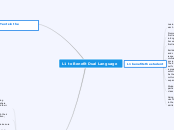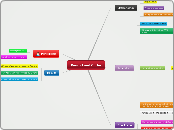L1 to Benefit Dual Language
L1 benefits the student
Going along with Gardner's Intelligence theories if we use the Musical Learner and regularly include songs in their first Language it can help develop reading skills and it can reinforce other skills and concepts
Students became more confident, speak more loudly, participate more vocally, and interact with their classmates when they have the option to use their L1
As the population of Canada is getting more multi-cultural, allowing kids to use their mother tongue will expand their knowledge of the ever changing world.
The ELL will develop their sense of identity and have self confidence and higher self-esteem; they will feel a greater sense of belonging, feel more supported emotionally.
Builds a sense of inclusive aspect within the school and classroom. Learning about, accepting, and respecting cultural differences, in an atmosphere of mutual respect, benefits our students, personally, and society in general.
Accessing prior knowledge through the use of their first language provides the framework for new learning.
Promoting literacy development in the ESL student's first language will facilitate the acquisition of literacy in English.
Learn to respect, appreciate, celebrate and develop each other’s unique character and strengths
What Can Teachers Do?
Work with other teachers/students and maintain a website that enables fellow teachers to access or download dual language stories to teach or inspire their ESL students (children helping children) or to showcase student-made multilingual stories.
Kid's learn a lot through "play" and teaching different cultural games will promote this type of community and kids will use it in the classroom and during recesses
Promote linguistic diversity (starting off small by simply saying "hello" or "good morning" in their other languages, you can even ask students to share their bilingual abilities by counting in their language.
As technology is becoming so advanced it is a good idea to assist in the development of computer literacy skills with different uses of multilingual word processors.
To get the other students to be more aware make sure to broaden their horizons by increasing their appreciation of different languages, cultures, and each other
Allow students to express themselves through their first language in oral and written communication, which will allow them to feel welcome
Collaborate with caregivers to create an inviting atmosphere in the school (e.g., parents can share information about their countries of origin and their cultures, or translate newsletters, etc.)
Building upon collaboration with the parents it might be a good idea to invest in a multilingual word-processing software and training parent volunteers to use them
Parents can also try to relate "folk tales" or cultural narratives, written down and audio recorded, to add to the school's literature collection
Dual Language Texts in the Classroom?
Multilingual signs (e.g., chalkboard, desk, supplies bin) around the classroom
Show and Tell Days in your classroom with a twist of incorporate their culture.
Multilingual Poetry Café:every student has to bring a poem (it can be in another language); give a translation and a cultural background
Various activities with webbing:
The children tell the story in their own language and see if they can also tell it in English or have someone to help them to translate it into English
Children’s digital library visit:
childrenlibrary.org
Dual Language Stories/Books;
especially ones with a lot of visual support
Posters (Done in two different languages)
Label them
Subtopic









